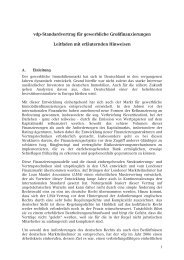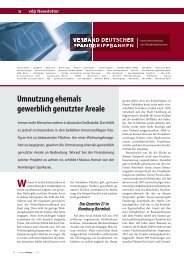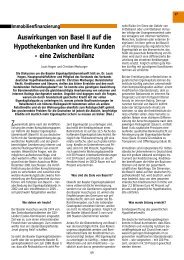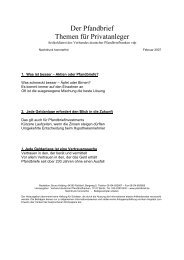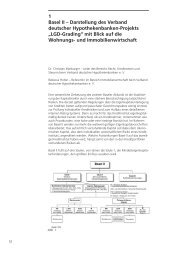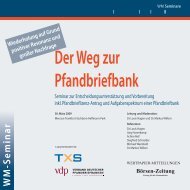The Pfandbrief 2011 | 2012
The Pfandbrief 2011 | 2012
The Pfandbrief 2011 | 2012
Create successful ePaper yourself
Turn your PDF publications into a flip-book with our unique Google optimized e-Paper software.
Effects of Basel III on the <strong>Pfandbrief</strong>-based lending business<br />
Development of regulatory capital requirements under Basel III<br />
12%<br />
Tier 1 (core) capital<br />
10%<br />
Conservation buffer<br />
(consisting of common<br />
equity Tier 1 capital)<br />
Common equity Tier 1<br />
capital<br />
Hybrid capital<br />
Supplementary (Tier 2)<br />
capital<br />
8%<br />
6%<br />
4%<br />
2%<br />
0%<br />
2%<br />
2%<br />
4%<br />
2%<br />
2%<br />
4%<br />
3.5%<br />
1%<br />
3.5%<br />
4%<br />
1.5%<br />
2.5%<br />
4.5%<br />
1.5%<br />
2%<br />
0.625%<br />
4.5%<br />
1.5%<br />
2%<br />
1.25%<br />
4.5%<br />
1.5%<br />
2%<br />
1.875%<br />
4.5%<br />
1.5%<br />
2%<br />
2.5%<br />
4.5%<br />
1.5%<br />
2%<br />
Countercyclical capital buffer<br />
0% to 2.5% common equity Tier 1 capital – national discretion<br />
No longer qualifying<br />
capital instruments (Tier 1 + 2)<br />
Deductions<br />
10-year transition phase<br />
20% 40% 60% 60% 100%<br />
<strong>2011</strong> <strong>2012</strong> 2013 2014 2015 2016 2017 2018 2019<br />
32<br />
New capital requirements introduced to reflect the counterparty credit risks of OTC derivatives<br />
will be particularly relevant to <strong>Pfandbrief</strong> banks that have included derivatives in cover<br />
in order to address interest-rate or exchange-rate risks. Here, the Basel III rules provide for<br />
the introduction of a regulatory capital requirement for the CVA (Credit Valuation Adjustment)<br />
risk, understood to refer to the risk of mark-to-market losses on derivatives due to deterioration<br />
in the credit risk of the derivative counterparty. As a rule, the appropriate capital charge<br />
is determined at the level of the entire derivative portfolio, using a prescribed regulatory formula<br />
which, in particular, includes the EaD (Exposure at Default) values and the credit-risk<br />
weighting, determined using the methods already applied for the purposes of the default risk<br />
capital charge. For derivative contracts entered into with a central counterparty, the previous<br />
exposure exemption will be repealed. However, for such derivatives, a privileged risk weighting<br />
is proposed in order to preserve the incentive to clear through central counterparties. In<br />
addition, banks using the IRB approach will be subject to higher capital charges for exposures<br />
to most companies in the finance industry, as the Basel III rules increase the measure used for<br />
the systematic risk of such companies within the risk-weighting formula.<br />
Excursus: Treatment of mortgage loans under CRD IV<br />
<strong>The</strong> CRD IV is intended not only to implement the Basel III framework at the level of the EU,<br />
but also to bring about further standardisation of the regulatory framework in Europe by abolishing<br />
national options and discretionary powers (creation of a “Single Rule Book”). Especially<br />
relevant to <strong>Pfandbrief</strong> banks in this regard is the planned revision of options for privileged<br />
treatment of mortgage loans within the context of regulatory risk-weighting. Above all the proposal<br />
suggests to<br />
introduce a “hard test”, within the meaning of Article 35, paragraph 3, clause 2 of the German<br />
Solvency Regulation (SolvV) in the residential property segment (as a precondition for




